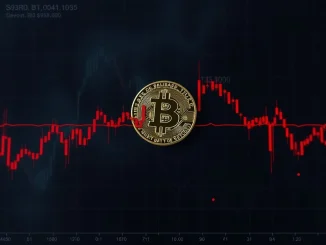
Are you wondering what’s next for the Bitcoin price? Recent market movements suggest a significant shift is underway, prompting caution among traders and investors. While the long-term outlook for Bitcoin remains bullish, several key technical indicators are flashing warning signs for the short term. Let’s dive into the details that could signal a potential 20% drop for the world’s leading cryptocurrency.
Decoding the Bearish Bitcoin RSI Divergence
One of the most compelling signals pointing to a potential downturn is the Bitcoin RSI (Relative Strength Index) bearish divergence. This pattern emerges when Bitcoin’s price achieves higher highs, but its 14-period RSI fails to follow suit, instead forming lower highs. This indicates weakening upward momentum, suggesting that buyers are losing conviction despite price increases.
- Historical Precedent: A similar hidden bearish divergence observed in March 2024 preceded a notable 20% price correction. This historical context suggests that the current pattern could lead to a comparable retracement as Bitcoin consolidates near the $115,000–$120,000 range.
- What it Means: For traders, a bearish divergence often signals that the underlying strength of an uptrend is fading, making it a critical indicator to watch for potential reversals.
The Critical CME Gap and Its Magnet Effect on BTC Price
Another significant factor amplifying bearish expectations is the unresolved CME gap. This refers to a price range on the Chicago Mercantile Exchange (CME) Bitcoin futures chart where trading activity ceased over a weekend or holiday, creating a ‘gap’ when the market reopens. Bitcoin has a historical tendency to ‘fill’ these gaps, acting like a magnet for price action.
- Current Gap: There’s a critical CME gap between $114,380 and $115,635 that remains unfilled.
- Historical Trend: In 2025 alone, seven out of nine previous CME gaps have already been closed. The remaining void represents a strong pull for Bitcoin’s price, increasing the likelihood of a short-term dip toward the $115K mark to close this range. This phenomenon is a well-known aspect of BTC analysis, often influencing short-term price movements.
Broader Market Cyclicality and On-Chain Signals
The current market dynamics align with broader cyclical trends. The Index Bitcoin Cycle Indicator (IBCI) has recently entered a ‘distribution zone.’ This phase is historically associated with interim market tops and periods of profit-taking by early investors.
While the IBCI hasn’t yet reached the ‘100% euphoria’ level seen in previous bull market peaks, other metrics provide a nuanced view:
- Puell Multiple & STH-SOPR: These indicators remain below mid-levels, suggesting that retail speculation and miner activity have not yet reached their peak, potentially leaving room for further upside in the long term.
- Long-Term Holders (LTHs): On-chain data indicates that LTHs have begun distributing some of their holdings. The CDD (Coin Days Destroyed) ratio has hit historic lows, which surprisingly indicates reduced selling pressure from large, long-term investors. This suggests that while some profit-taking is occurring, there isn’t a widespread capitulation from seasoned holders.
- Retail Hesitancy: Conversely, retail holders appear hesitant to offload their positions, maintaining liquidity within the $115K–$120K range. This delicate balance creates a fragile market environment, as evidenced by a sharp 2% drop to $117,634 on July 24, triggered by stalled ETF inflows and bearish options activity.
Analyst Perspectives and Macro Factors Impacting the Cryptocurrency Market
Analysts are currently divided on Bitcoin’s immediate future. Some view the current consolidation as a healthy correction, a necessary pause before a potential breakout toward $135K. They argue that such corrections are vital for sustainable growth.
However, others warn that a decisive break below the $115K support level could trigger further consolidation, potentially pushing the price down to $110,530. For the bullish case to be validated, a strong move above $122K with significant trading volume would be required.
Macroeconomic factors also play a crucial role in the broader cryptocurrency market sentiment:
- Equity Market Correlation: Bitcoin’s price has recently shown a tendency to track equity trends. A recent trade deal-driven surge in the Dow Jones, which added 400 points, has contributed to heightened market volatility.
- Institutional Buying: Bearish sentiment intensified following a 2% intraday decline on July 24, as sellers accumulated near $118K and on-chain metrics showed a reduction in institutional buying pressure. This suggests that large institutional players are currently taking a more cautious stance.
Conclusion: Navigating Short-Term Volatility with Long-Term Vision
While the long-term bull trend for Bitcoin appears to remain intact, the short-term risks are considerable. The confluence of a bearish RSI divergence, an unfilled CME gap, and signals from the IBCI and on-chain data strongly suggests that key support levels between $115K–$118K will be heavily tested in the coming weeks. Traders and investors should exercise caution, closely monitor these technical indicators, and consider their risk management strategies in light of the potential for a significant price correction. Staying informed and prepared will be crucial in navigating these volatile market conditions.
Frequently Asked Questions (FAQs)
Q1: What is a Bitcoin RSI bearish divergence and why is it important?
A Bitcoin RSI bearish divergence occurs when the price of Bitcoin makes higher highs, but its Relative Strength Index (RSI) makes lower highs. This indicates weakening momentum and suggests that the upward trend might be losing strength, often preceding a price correction. It’s important because it provides an early warning signal for potential reversals.
Q2: How does the CME gap influence Bitcoin’s price?
A CME gap refers to a price range on the Chicago Mercantile Exchange Bitcoin futures chart where trading stops over a weekend or holiday, creating a ‘gap’ when the market reopens. Historically, Bitcoin’s spot price tends to ‘fill’ these gaps, meaning the price often moves to close the range left open on the futures chart. This makes the CME gap a strong magnet for price action.
Q3: What does the Index Bitcoin Cycle Indicator (IBCI) entering a ‘distribution zone’ signify?
When the IBCI enters a ‘distribution zone,’ it suggests that the market is in a phase historically associated with interim tops and profit-taking by long-term holders and smart money. It doesn’t necessarily signal the end of a bull market but indicates a period where selling pressure might increase as investors realize gains.
Q4: What are the key support levels to watch for Bitcoin in the short term?
Based on current technical analysis and market dynamics, key support levels for Bitcoin are expected to be heavily tested between $115,000 and $118,000. A break below $115,000 could lead to further consolidation towards $110,530.
Q5: Is the long-term bull trend for Bitcoin still intact despite these short-term warnings?
Yes, most analysts agree that the long-term bull trend for Bitcoin remains intact. The current signals suggest a potential short-term correction or consolidation phase, which is often considered healthy for sustainable long-term growth. These dips can present opportunities for investors looking to accumulate at lower prices.



